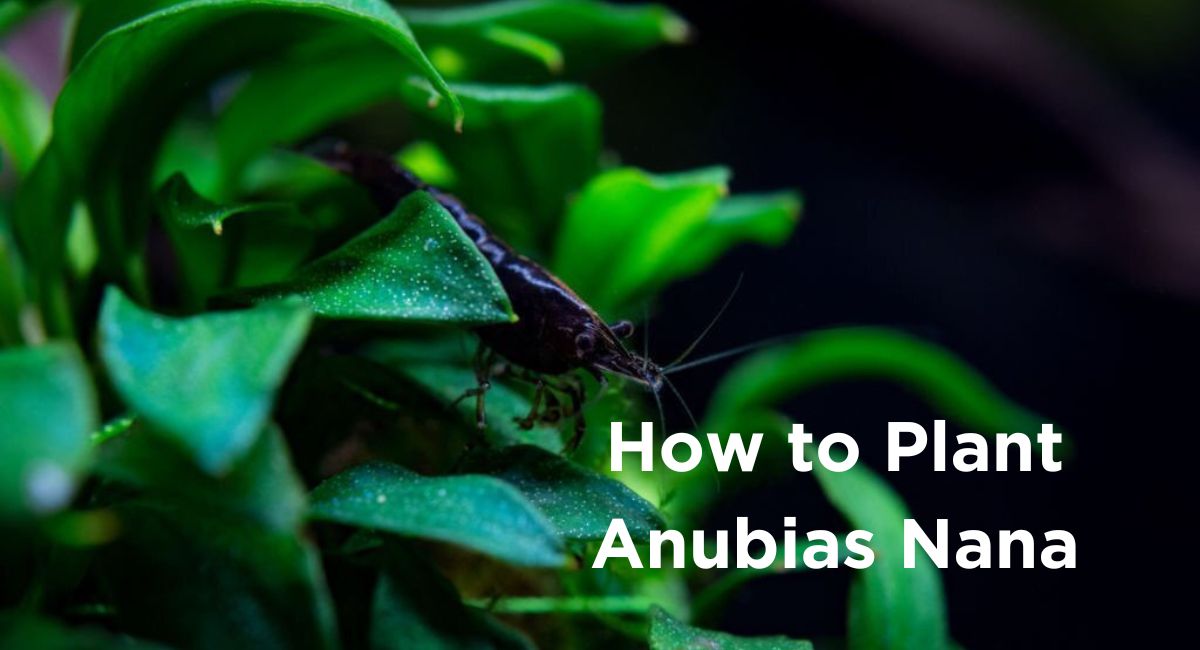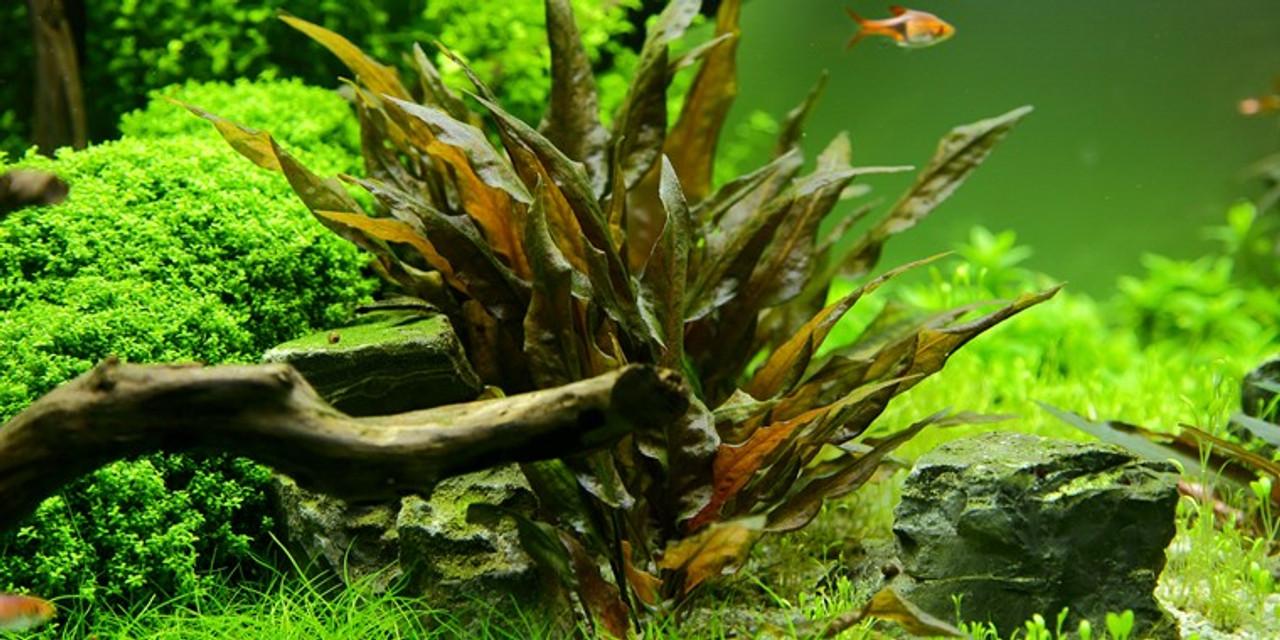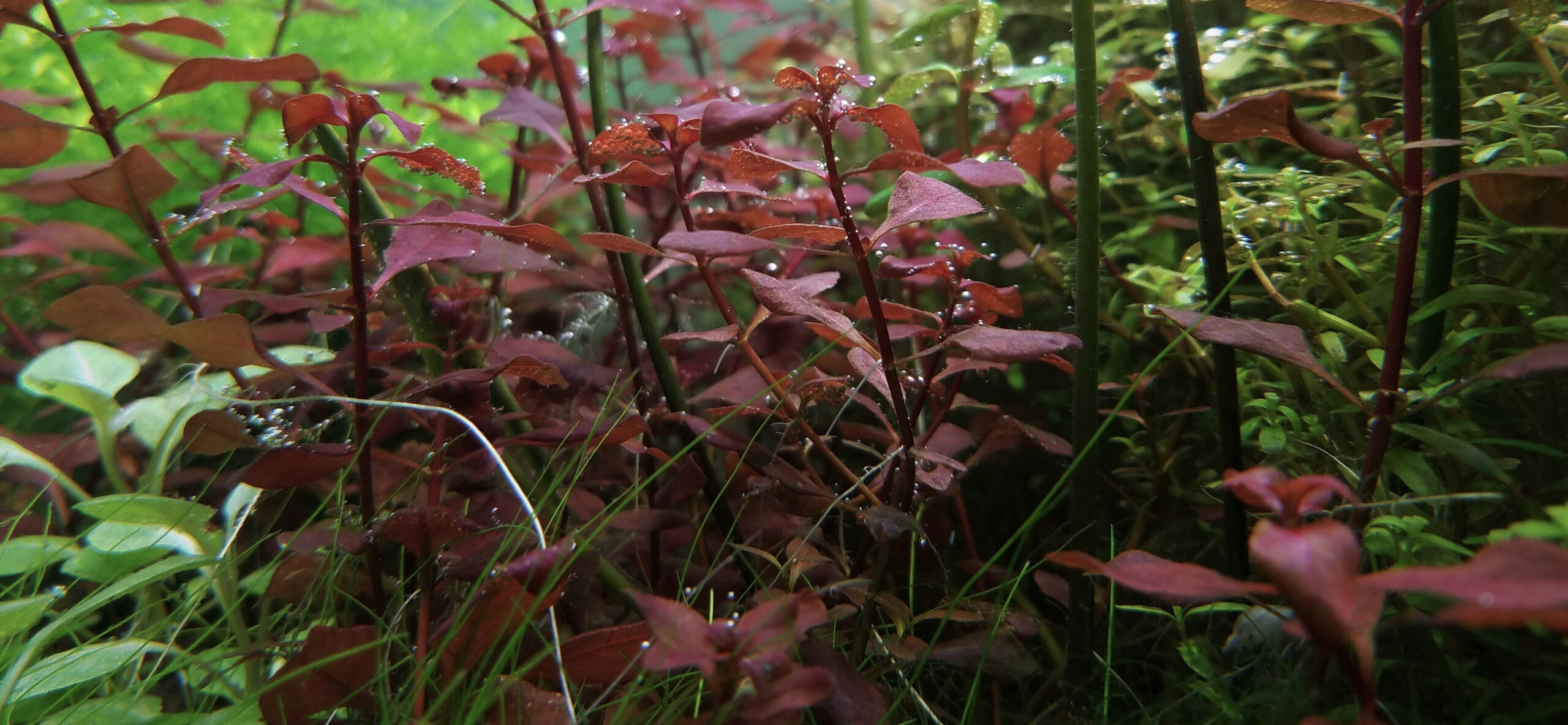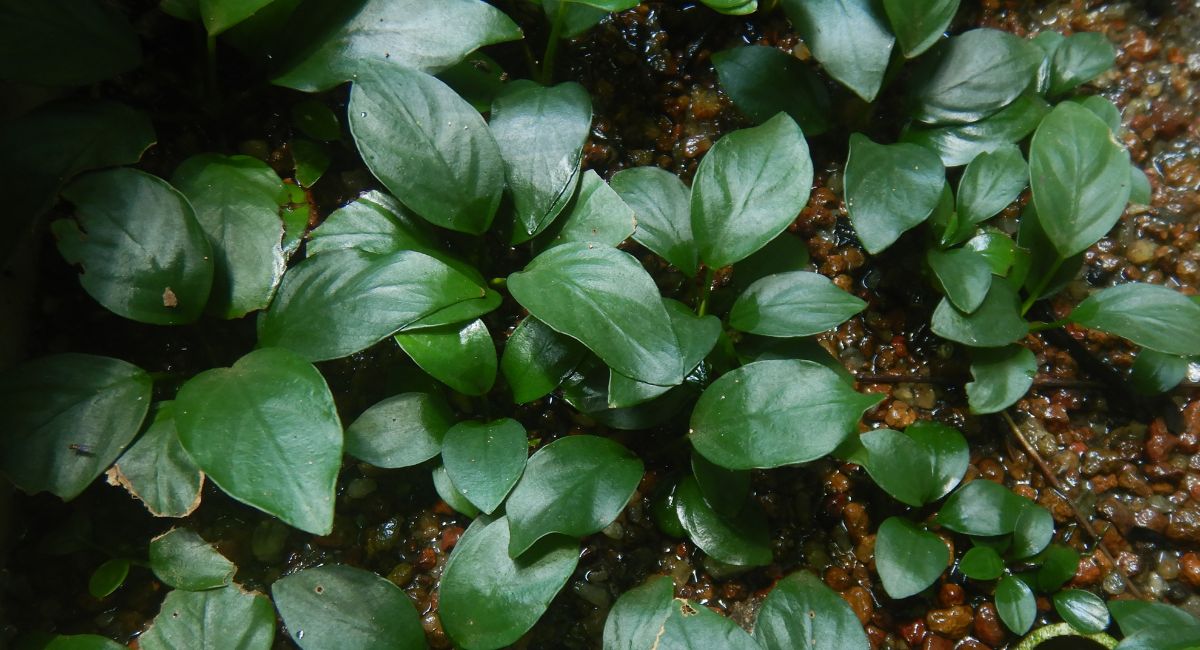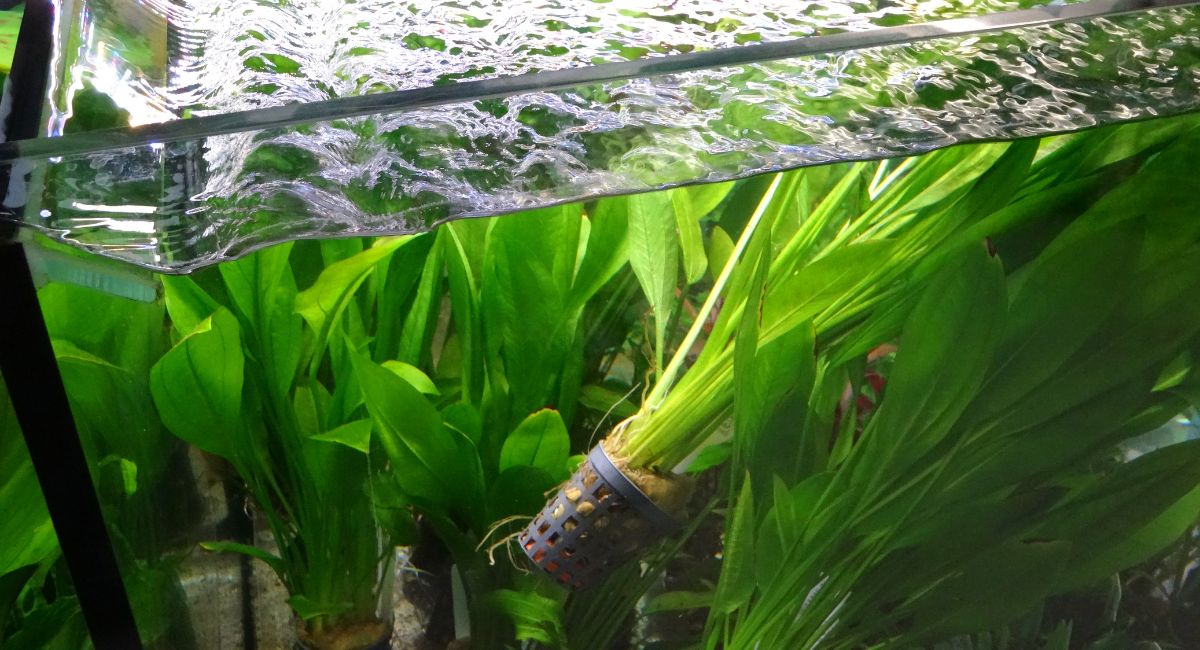Smartplantedaquarium.com participates in affiliate marketing programs. We may earn commissions on purchases made through our affiliate links. This doesn't affect our content or recommendations and we only recommend products we would put in our own tanks.
Anubias nana, also known as Dwarf Anubias or Anubias nana petite, is a captivating aquatic plant that hails from the lush riverbanks of West Africa. This small and hardy freshwater plant belongs to the Araceae family and is a popular choice among aquarists and hobbyists worldwide. Its beauty lies in its lush, vibrant green leaves that provide an enchanting touch to any aquarium setting.
There are several reasons why Anubias nana stands out as an excellent addition to any aquarium. First and foremost, its undemanding nature makes it a perfect choice for both beginners and experienced enthusiasts. The plant requires minimal care, making it an ideal option for those looking to introduce live plants without the burden of complicated maintenance.
In the following sections, we will delve into the specifics of how to plant Anubias nana, including essential aspects like lighting, substrate, propagation, and fertilization.
Whether you’re a seasoned aquarium enthusiast or a novice looking to embark on the journey of underwater gardening, this comprehensive guide will equip you with the knowledge needed to cultivate and appreciate the beauty of this plant in your aquarium.
Contents
- Overview of Anubias Nana
- Requirements for Planting Anubias Nana in Your Aquarium
- How to Plant Anubias Nana
- Plant Care Timeline for Anubias Nana
- Mistakes to Avoid When Planting Anubias Nana
- Frequently Asked Questions
- 1. What are the best companion plants for Anubias Nana?
- 2. What are the best tank mates for Anubias Nana?
- 3. How fast does Anubias Nana grow?
- 4. How big does Anubias Nana grow?
- 5. What is the growth pattern of Anubias Nana?
- 6. Can you propagate Anubias Nana?
- 7. Is Anubias Nana suitable for beginners?
- 8. Is Anubias Nana suitable for a low-tech aquarium?
- Conclusion
Overview of Anubias Nana
Anubias nana, also known as Dwarf Anubias or Anubias nana petite, is a captivating aquatic plant originating from the lush riverbanks of West Africa. Belonging to the Araceae family, this small and hardy freshwater plant has gained popularity among aquarists and hobbyists worldwide. Its enchanting beauty lies in its lush, vibrant green leaves, which add a touch of charm to any aquarium setting.
| Attribute | Description |
|---|---|
| Scientific Name | Anubias nana |
| Common Name | Dwarf Anubias, Anubias nana petite, Anubias nana gold, Anubias nana var. nana, Anubias barteri var. nana |
| Origin | West Africa |
| Difficulty Level | Easy |
| Light Requirement | Low to Medium |
| Water Conditions | pH 6.0 – 7.5, Soft to Moderately Hard |
| Best Temperature | 72°F – 82°F (22°C – 28°C) |
| Substrate | Not Buried, Tied or Attached to Rocks or Driftwood |
| Position in Tank | Foreground or Midground |
| Growth Rate | Slow |
| Maximum Size | 5 – 7 inches (12 – 18 cm) |
| Compatible Plants | Java Fern, Anubias Barteri, Java Moss, Cryptocoryne |
| Ideal Tank Mates | Small Fish, Shrimp, Snails |
| Feeding and Nutrients | None required, can benefit from liquid fertilizers |
| Maintenance and Care | Low; Remove debris from leaves, trim dead parts |
| Propagation | Rhizome Division or Cuttings |
Requirements for Planting Anubias Nana in Your Aquarium
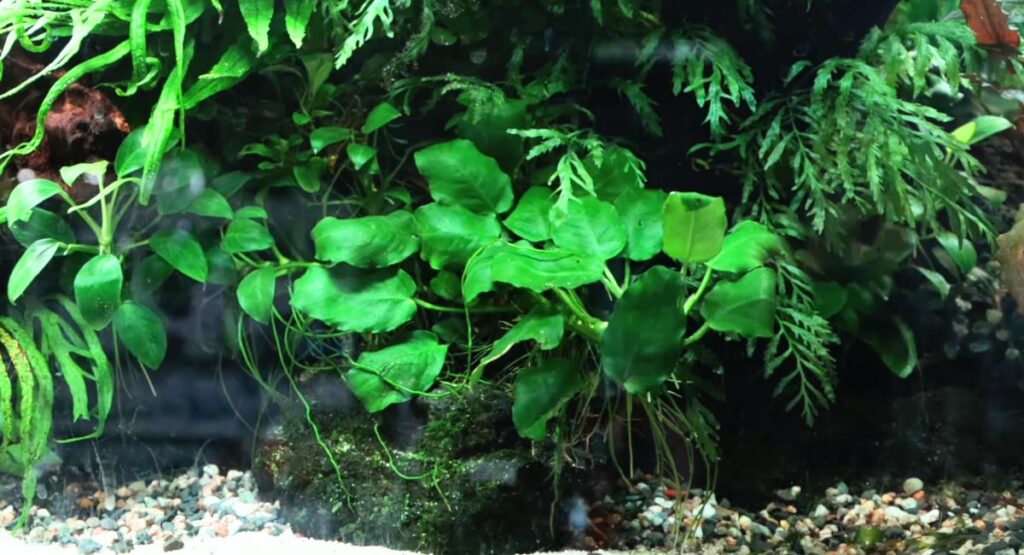
When it comes to introducing Anubias barteri var. nana into your aquarium, there are crucial factors that you must consider to ensure its flourishing growth. This section will guide you through the essential requirements for successfully cultivating this beautiful aquatic gem in your tank. From the right amount of light to ideal water conditions and substrate choices, we’ll cover everything you need to know to create a thriving environment for your plant.
Light
Anubias nana is well-known for its adaptability to varying light conditions. While it can survive in low to medium light, providing it with proper illumination will encourage healthier and lusher growth. For best results, aim for around 8 to 10 hours of light per day. Consider using fluorescent, LED, or full-spectrum bulbs to create a natural and vibrant environment.
Avoid exposing it to intense direct light, as it may lead to algae growth on the plant’s leaves. It’s also advisable to place the plant in shaded areas or use taller aquarium plants to provide partial shading. Finding the right balance of light will help maintain the plant’s attractive appearance and prevent any potential light-related issues.
Water Conditions
Anubias nana thrives in relatively stable and clean water conditions. Maintaining a water temperature between 72°F to 82°F (22°C to 28°C) is ideal for this plant’s health and growth. Additionally, keeping the water slightly acidic to neutral with a pH range of 6.0 to 7.5 ensures a conducive environment.
When it comes to water hardness, Anubias barteri var. nana prefers moderately soft to moderately hard water. Strive for a general hardness (GH) level between 4 to 8 dGH to keep your plant content.
Regularly monitoring and maintaining water quality is essential, as any fluctuations may stress the plant and impact its overall well-being. Perform routine water changes, remove any debris, and keep an eye on water parameters to ensure your plant remains in prime condition.
Substrate
Unlike many other aquatic plants, Anubias nana shouldn’t be buried in the substrate. Instead, its rhizome (horizontal stem) must be left exposed and not covered by gravel or sand. The plant can be attached to rocks, driftwood, or other hardscape elements using fishing line, thread, or plant glue.
This unique characteristic of Dwarf Anubias makes it an excellent choice for aquascaping, as it allows you to create captivating layouts with ease. The absence of a substrate burial requirement simplifies planting and minimizes any disturbance to the plant during maintenance activities.
How to Plant Anubias Nana
Embarking on the journey of planting Anubias nana in your aquarium is an exciting endeavor. This step-by-step guide will lead you through the process, ensuring a successful and aesthetically pleasing arrangement of these captivating aquatic gems. From preparing your aquarium to post-planting care, we’ve got you covered. Let’s dive in!
Step 1: Preparing Your Aquarium
Before introducing Anubias nana into your aquatic haven, it’s essential to ensure that your aquarium is ready to provide a conducive environment for the plant to flourish. Perform a thorough check to make sure the water parameters are within the recommended range: pH between 6.0 to 7.5 and a temperature of 72°F to 82°F (22°C to 28°C). Additionally, verify that your lighting setup is suitable for low to medium light plants.
Ensure that any hardscape elements, such as rocks or driftwood, are in place and positioned where you want to attach the plant. Properly arrange the substrate and any other plants that will coexist harmoniously with Dwarf Anubias. Taking the time to prepare your aquarium will provide a stable foundation for the plant’s growth.
Step 2: Preparing Anubias Nana
Before planting, it’s essential to prepare the Anubias nana to encourage a smooth transition into its new environment. Inspect the plant for any damaged or discolored leaves and trim them if necessary, as this will promote healthier growth.
To prevent potential algae issues, soak the plant in water for a short time before planting. This helps remove any potential contaminants and ensures a cleaner start. While Anubias barteri var. nana is hardy and adaptable, providing it with a healthy start will boost its chances of thriving in your aquarium.
Step 3: Planting Anubias Nana
Planting Anubias nana is straightforward, thanks to its unique characteristic of not requiring burial in the substrate. Instead, gently attach the plant’s rhizome to rocks or driftwood using fishing line, thread, or plant glue. You can also tuck the rhizome into crevices or tie it to the hardscape elements.
Ensure that the rhizome is above the substrate and exposed to the water, as burying it may lead to rot and adversely affect the plant’s health. Place Dwarf Anubias in the foreground or midground of your aquarium, leaving sufficient space between each plant to allow for growth and prevent overcrowding.
Step 4: Post-Planting Care
After planting, maintain a watchful eye on your Anubias nana to ensure it acclimates well to its new surroundings. Avoid any sudden changes in lighting, water conditions, or temperature, as this may stress the plant.
Perform routine maintenance by gently removing debris from the plant’s leaves and trimming any dead parts, if necessary. Ensure water quality remains optimal by performing regular water changes.
Plant Care Timeline for Anubias Nana
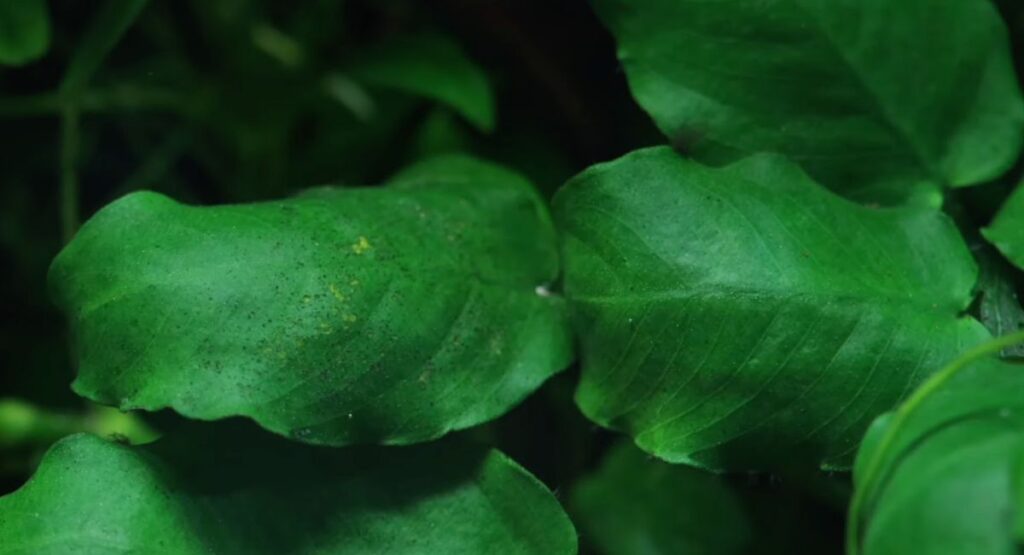
Caring for your Anubias nana requires consistency and attention to detail. Following a well-planned care timeline will help ensure the plant’s health and vibrant growth. Here’s a comprehensive guide to the essential care tasks you should perform throughout the life of your plant:
Weekly Tasks
- Inspect for Algae: Check the leaves of your Anubias nana for any signs of algae growth. If you notice any, gently wipe it off with a soft cloth or algae brush.
- Remove Debris: Carefully remove any debris, dead leaves, or uneaten fish food around the plant to maintain a clean environment.
Bi-Weekly Tasks
- Check Water Parameters: Monitor water pH, temperature, and hardness every two weeks to ensure they remain within the suitable range for Anubias nana.
Monthly Tasks
- Fertilize (if needed): Depending on your setup, you may choose to add liquid fertilizers with trace elements once a month. Observe the plant for any signs of nutrient deficiency, such as yellowing leaves.
- Trim Dead Leaves: Trim any yellowed or decaying leaves close to the rhizome using sterilized scissors. This encourages new growth and keeps the plant looking tidy.
Every 2-3 Months
- Check for Pests: Inspect the Anubias nana and surrounding areas for any signs of pests like snails or algae-eating fish. If pests are present, take appropriate measures to remove them.
As Needed
- Attach or Re-attach to Hardscape: Over time, the Anubias nana may become dislodged from its original attachment. As needed, re-attach the plant’s rhizome to rocks or driftwood using fishing line or thread.
- Monitor Growth: Keep an eye on the plant’s growth and adjust its position in the aquarium if it starts overshadowing other plants or aquarium inhabitants.
Mistakes to Avoid When Planting Anubias Nana
While Anubias nana is a hardy and versatile aquatic plant, there are some common mistakes that aquarists can make when planting and caring for it. Avoiding these pitfalls will help ensure the long-term health and beauty of your plant. Let’s explore the key mistakes to steer clear of:
Burying the Rhizome: Anubias nana’s rhizome must never be buried in the substrate. Burying the rhizome can lead to rot and eventually kill the plant. Instead, attach the plant to rocks or driftwood, allowing the rhizome to remain exposed to the water.
Overcrowding: Avoid planting Dwarf Anubias too close to other plants or hardscape elements. Overcrowding can hinder its growth and restrict access to light and nutrients.
Too Much Light: While Anubias barteri var. nana can thrive in low to medium light, exposing it to intense, direct light can promote algae growth on the leaves. Ensure that the lighting is appropriate for the plant’s needs.
Neglecting Water Quality: This plant prefers stable and clean water conditions. Neglecting water quality, including temperature, pH, and hardness, can lead to stress and deterioration of the plant’s health.
Using Copper-Based Medications: Anubias nana is sensitive to copper, which is often found in some aquarium medications. Avoid using copper-based treatments as they can be toxic to the plant.
Trimming Incorrectly: When trimming dead or decaying leaves, ensure you trim as close to the rhizome as possible. Avoid cutting healthy leaves or damaging the rhizome during trimming.
Skipping Regular Maintenance: Even though Anubias barteri var. nana is low-maintenance, it still requires routine care. Skipping regular maintenance, such as debris removal and water changes, can lead to issues in the long run.
Uncontrolled Pests: Keep an eye out for pests like snails or algae-eating fish that might harm the plant. Address any pest issues promptly to protect your Anubias nana.
Ignoring Plant Compatibility: While Dwarf Anubias is generally compatible with various tank mates, some species may be more aggressive and damage the plant. Research the compatibility of your aquatic inhabitants to avoid any conflicts.
Frequently Asked Questions
1. What are the best companion plants for Anubias Nana?
Anubias Nana pairs well with other low-light, slow-growing plants. Some great companion plants include Java Fern, Java Moss, Cryptocoryne species, and other Anubias varieties like Anubias Barteri. These plants share similar care requirements, making them ideal tank mates for Anubias Nana.
2. What are the best tank mates for Anubias Nana?
Anubias Nana is a peaceful plant that can coexist harmoniously with various fish species and invertebrates. Small, non-aggressive fish like Tetras, Rasboras, Gouramis, and Corydoras make excellent tank mates. Shrimp, snails, and other docile invertebrates are also suitable companions for this plant.
3. How fast does Anubias Nana grow?
Anubias Nana has a slow growth rate compared to many other aquarium plants. Under optimal conditions, you can expect it to grow around 1 to 2 leaves per month. Its slow growth contributes to its manageable size, making it an ideal choice for aquascaping.
4. How big does Anubias Nana grow?
Anubias Nana is a relatively compact plant, typically reaching a size of 5 to 7 inches (12 to 18 cm) in height when fully grown. This size makes it a versatile addition to various aquarium setups without overpowering the tank’s layout.
5. What is the growth pattern of Anubias Nana?
Anubias Nana exhibits an attractive rhizome-based growth pattern. The rhizome extends horizontally, giving rise to individual leaves and roots. As the plant matures, it forms dense clusters of leaves, creating an appealing and eye-catching appearance in the aquarium.
6. Can you propagate Anubias Nana?
Yes, Anubias Nana can be easily propagated through rhizome division or by taking cuttings. To propagate through rhizome division, carefully separate the rhizome into smaller sections, each with healthy leaves and roots. Alternatively, you can take cuttings with at least a couple of leaves and plant them separately.
7. Is Anubias Nana suitable for beginners?
Yes, Anubias Nana is an excellent choice for beginners due to its hardiness and low-maintenance nature. It can adapt to various aquarium conditions and forgiving of minor care mistakes, making it a perfect option for those new to live aquarium plants.
8. Is Anubias Nana suitable for a low-tech aquarium?
Yes, Anubias Nana is well-suited for low-tech or low-light aquarium setups. Its ability to thrive in low to medium light conditions and minimal nutrient requirements make it an ideal choice for aquariums without high-tech lighting or CO2 supplementation.
Conclusion
Anubias nana is an easy to grow aquarium plant that does not even need to be planted in substrate. The key is to attach the rhizome to a piece of driftwood or rockwork using cotton thread or fishing line. Keep the rhizome above the substrate and avoid burying it.
Provide moderate lighting, a nutrient-rich substrate fertilized occasionally, and warm water conditions. With its low lighting and care requirements, slow growth rate, and hardiness, Anubias nana is an excellent choice for beginners and makes an attractive addition to aquascapes when used as a foreground or midground plant.
Following proper placement and care guidelines, anubias will readily propagate and produce new leaves to create a lush underwater landscape.
Also read How to Plant Amazon Frogbit, How to Plant Java Fern, How to Plant Amazon Sword Plant, and How to Plant Water Sprite.
